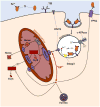The long history of iron in the Universe and in health and disease
- PMID: 21856378
- PMCID: PMC3258305
- DOI: 10.1016/j.bbagen.2011.08.002
The long history of iron in the Universe and in health and disease
Abstract
Background: Not long after the Big Bang, iron began to play a central role in the Universe and soon became mired in the tangle of biochemistry that is the prima essentia of life. Since life's addiction to iron transcends the oxygenation of the Earth's atmosphere, living things must be protected from the potentially dangerous mix of iron and oxygen. The human being possesses grams of this potentially toxic transition metal, which is shuttling through his oxygen-rich humor. Since long before the birth of modern medicine, the blood-vibrant red from a massive abundance of hemoglobin iron-has been a focus for health experts.
Scope of review: We describe the current understanding of iron metabolism, highlight the many important discoveries that accreted this knowledge, and describe the perils of dysfunctional iron handling.
General significance: Isaac Newton famously penned, "If I have seen further than others, it is by standing upon the shoulders of giants". We hope that this review will inspire future scientists to develop intellectual pursuits by understanding the research and ideas from many remarkable thinkers of the past.
Major conclusions: The history of iron research is a long, rich story with early beginnings, and is far from being finished. This article is part of a Special Issue entitled Transferrins: Molecular mechanisms of iron transport and disorders.
Copyright © 2011 Elsevier B.V. All rights reserved.
Figures



References
-
- Shayeghi m, latunde-dada go, oakhill js, laftah ah, Takeuchi k, Halliday n, Khan y, Warley a, mccann fe, hider rc, frazer dm, anderson gj, vulpe cd, simpson rj, mckie at. identification of an intestinal heme transporter. cell. 2005;122:789–801. - PubMed
-
- Qiu a, Jansen m, Sakaris a, min sh, Chattopadhyay s, Tsai e, Sandoval c, Zhao r, akabas mh, goldman id. identification of an intestinal folate transporter and the molecular basis for hereditary folate malabsorption. cell. 2006;127:917–928. - PubMed
-
- Hershko c, Graham g, bates gw, rachmilewitz ea. non-specific serum iron in thalassaemia: an abnormal serum iron fraction of potential toxicity. br J Haematol. 1978;40:255–263. - PubMed
Publication types
MeSH terms
Substances
Grants and funding
LinkOut - more resources
Full Text Sources
Medical
Research Materials
Miscellaneous

